

 Vol. 40 (Number 39) Year 2019. Page 19
Vol. 40 (Number 39) Year 2019. Page 19
BONDARENKO, Vladimir Viktorovich 1; TANINA, Maria Alekseevna 2; YUDINA, Vera Alexandrovna 3 & KHARITONOVA, Tatiana Viktorovna 4
Received: 26/08/2019 • Approved: 30/10/2019 • Published 11/11/2019
ABSTRACT: The article describes a new method for assessing the impact of the universities’ educational and research activities on the cultural and socio-economic level of regional development, based on regression models. Statistical processing of indicators of research activities enabled to calculate the MAPE ( mean absolute percentage error), Forecast Accuracy parameters, and the elasticity and determination coefficient. The effectiveness of the proposed method lies in the possibility of calculating the amount of financial resources needed to stimulate the universities’ research activities to increase the GRP level by 1-2 or more percent. |
RESUMEN: El artículo describe un nuevo método para evaluar el impacto de las actividades educativas y de investigación de las universidades en el nivel cultural y socioeconómico del desarrollo regional, basado en modelos de regresión. El procesamiento estadístico de los indicadores de las actividades de investigación permitió calcular el MAPE, los parámetros de Precisión de Pronóstico y el coeficiente de elasticidad y determinación. La efectividad del método propuesto radica en la posibilidad de calcular la cantidad de recursos financieros necesarios para estimular las actividades de investigación de las universidades para aumentar el nivel de GRP en un 1-2 o más por ciento. |
One of the important scientific problems lies in the development of methods for analyzing the impact of integrative educational and research activities of higher education institutions on the socio-economic component of regional development. In accordance with the global trends, the education system significantly affects the competitiveness and efficiency of national economies. In the context of innovative economy, the cognitive resource is becoming the core element, whose main generation centers comprise higher education institutions. In the national economy, a major share of intellectual potential is concentrated in the university sector of science, which develops and transfers knowledge in various fields of activity.
The modern system of higher education is able to attract and develop talented young people, create new knowledge and ensure its practical implementation in relation to the real sector of the regional economy, which becomes the main tool for the development of the knowledge-based economy. At the same time, universities are a generator for innovative development of the region, a center for translation of best practices into the territorial education system. Regional higher education institutions have a significant impact on the level of the socio-economic indicators of regional development.
The development of the global and national economies is largely determined by their ability to produce, use and commercialize new knowledge and technologies. In the world practice, the partnership of universities and companies is mainly implemented through research and development; joint design and implementation of programs; intellectual property protection; creating business projects and participation of business representatives in university management. Such forms of cooperation between universities and the real sector of the economy have a positive integrative effect on the socio-economic component of regional development.
Text Contemporary publications by B. Clark (1983), G. Sabato (1975), B.-A. Lundwala (1988), R. Nelson (1993), D. Charles (1995), D. Goddard and P. Chatterton (2000), G. Itskowitz (2000), Eidesdorf (2000), Altbach and Salmi (2012) state that a regional university shall be considered one of the main elements of the strategy for regional economic development.
The interaction processes that arise between the state, business and universities in the context of developing innovations for the purpose of knowledge economy are explained by the Triple Helix Model of H. Etzkowitz and L. Leydesdorff (2003).
The model of multifunctional and multi-level participation of the university in the regional development proposed by P. Arbo and P. Benneworth (2007) is based on the variety of functions of modern universities and the consequences of their implementation for regional development. Financing the universities’ research activities creates a platform for their formation as the strongest drivers for the development of the regional economy.
J.B. Goddard and P. Chatterton (2000) believe that importance of universities for regional development lies in their ability to focus on regional development issues and involve other interested stakeholders. In addition, higher education institutions make a significant contribution to regional development; their importance is achieved by satisfying the needs of the regional labor market by training specialists, conducting relevant research, as well as through their ability to attract foreign investment and capital.
The following models of cooperation between universities and the real sector of the economy have currently been formed in the international best practice at the territorial level:
1. Cooperation in the development of joint research initiatives (Tynnikov, 2014);
2. Development of joint educational programs (Ramísio et al., 2019);
3. Student mobility (Shields, 2019; Hashim et al., 2018; Hamoud & Humadi, 2019).
An example of cooperation between universities and the real sector of the economy in the R&D field can be seen in the technology transfer centers in China. The Technology Transfer Center is an organization whose activity is aimed at introducing the results of scientific and technical activities into the real economy and is focused on making profit from the use of research results carried out in public universities and private companies (Xu et al., 2016).
The Chinese university system is one of the world’s largest performers of high-tech research (Hu et al., 2018). Each university has its own technology transfer model in the form of a technology transfer center (university’s associated private companies): programs for improving competitiveness of higher education; programs for improving university research standards; creating hybrid public-private partnerships; increasing the number of patents (Hanushek, 2016).
To assess the role of universities in regional development in economically developed countries today, various models are used to analyze the contribution of university science to the socio-economic, innovation and cultural development of regions. For example, the studies of B. Clark (2003), D. Goddard and P. Chatterton (2004), G. Etzkowitz and L. Leydesdorff (2003), D. Caffrey and H. Isaacs (2012), E.A. Hanushek, and L. Woessmann (2015), Yao Yao (2019) determine that a regional university should be a core element of the economic strategy for regional development.
D. Caffrey and H. Isaacs (2012) proposed a generally accepted method for assessing the contribution of higher education to regional development, which suggests considering higher education as an industry. The essence of the approach is to assess the difference between the income base and the results of universities’ activities affecting the development of the regional economy. As a rule, such impact is assessed through the following indicators:
- Cost of the real estate owned by the business associated with the university;
- Volume of state funding for the university;
- Number of jobs and their total cost created by the university (for example, employees of enterprises hired to work with universities);
- Size of deposits made by universities, university staff, and students in local banks;
- Funds spent by students (and teachers), who are not residents of the city, for the purpose of living in this city;
- Amount of taxes paid by the university, university employees, business entities and organizations affiliated with universities, to the city (regional) budget;
- Cost of business where the university is a co-founder or owner.
According to the model of J.B. Goddard and P. Chatterton (2004), the value of universities for the region lies in their ability to focus on the territorial problems, become a moderator of field discussions and form a pool of stakeholders to solve them. In addition, universities contribute to regional socio-economic development by meeting the needs of the regional labor market.
The regional system of higher education is a set of interrelated and interdependent education subjects, components that ensure professional training, retraining, and staff development at federal; and regional levels of the social order and at the level of employers (as a customer of R&D works).
The systemic approach was used in this scientific study, which lies in studying objects as systems. The methods of systemic, comparative, statistical analysis, questioning and expert survey were also used.
The original proprietary method for studying the impact of the universities’ research activities on the GRP level includes the following stages:
1. Determine the values of the key indicators of the universities’ research activities in accordance with statistical data (factor attribute);
2. Determine the GRP values in accordance with statistical data (resulting attribute);
3. Carry out correlation and regression analysis based on calculation of the correlation coefficient, formation of the regression equation, Student’s t-test, elasticity coefficient, and determination coefficient;
4. Build trend lines and find the forecast level for the indicators of the universities’ research activities (factor attribute);
5. Use the found predicted values of the indicators of the universities’ research activities in the regression equation and get the predicted GRP values (resulting attribute);
6. Then verify the accuracy of the predicted values based on the MAPE and Forecast Accuracy criteria and confirm the accuracy of the predictions and calculations.
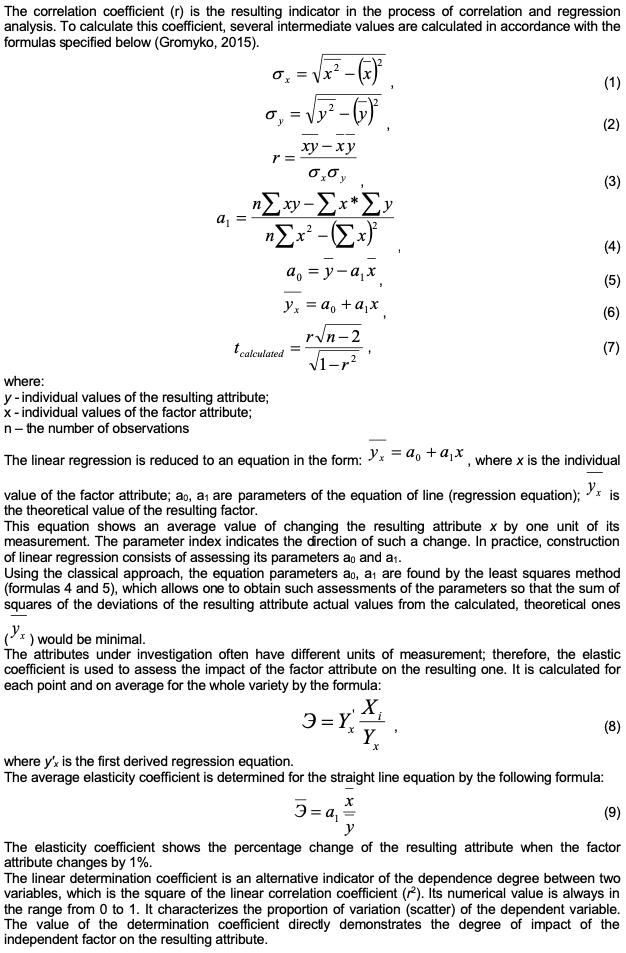
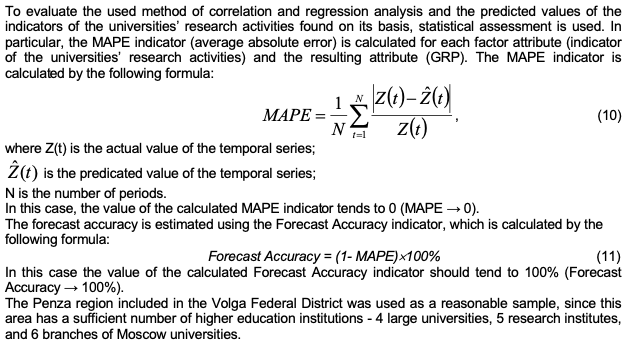
There are the following research institutes in the Penza region:
- OJSC “Research and Development, Design and Technological Institute of Chemical Engineering”;
- “NIIFI and VT”, a branch of NIIFI JSC (research, development and manufacture of electronic equipment for various purposes, computer equipment for automated control systems and specialized control systems);
- JSC “Research and Development Institute of Electromechanical Instruments”;
- JSC “Penza Scientific Research Electrotechnical Institute”.
Higher education institutions of the region conduct scientific research and development in the field of technical, natural, humanitarian, public and other sciences. A significant amount of scientific research is supported by national and regional funding; some projects are implemented jointly with JSC Development Corporation of the Penza Region. Over the past three years, universities in the region have been considered effective as a result of state monitoring conducted by the Ministry of Education and Science of the Russian Federation.
One of the purposes of the study was to identify a set of indicators of regional development, which are subject to the influence of the universities’ activities in the field of research, development and innovation. At the same time, the gross regional product (GRP) should be considered as the most important indicator of regional development, directly and indirectly dependent on the universities’ activities. In order to identify the impact of key indicators for the purpose of evaluating the effectiveness of universities’ activities on the GRP indicator, the authors conducted a correlation and regression analysis of the socio-economic indicators of the region (as a case study of the Penza Region).
Table 1 presents the results of the correlation-regression analysis of the dependence between the size of the GRP in the Penza region and the amount of expenses for research and development.
Table 1
Correlation-regression analysis of the dependence between the GRP in the Penza region
and the amount of internal expenses for research and development (Federal State Statistics
Service of Russia, 2019
Year |
Internal expenses for R&D, million rubles, х |
GRP in the Penza region, billion rubles, у |
x2 |
ху |
y2 |
yx
|
2013 |
4539.5 |
270.4 |
20606697.1 |
1227470.0 |
73116.2 |
377.6 |
2014 |
3518.5 |
295.2 |
12379594.5 |
1038650.8 |
87143.0 |
294.1 |
2015 |
3645.2 |
343.3 |
13287483.0 |
1251397.2 |
117854.9 |
304.4 |
2016 |
3793.6 |
348.9 |
14391401.0 |
1323587.0 |
121731.2 |
316.6 |
2017 |
3962.0 |
365.2 |
15697444.0 |
1446922.4 |
133371.0 |
330.3 |
Sum |
19458.7 |
1623.0 |
76362619.6 |
6288027.4 |
533216.3 |
1598.3 |
Average value |
3891.7 |
324.6 |
15272523.9 |
1257605.5 |
106643.3 |
324.6 |
Average square |
15145678.8 |
105365.2 |
233249987134015.0 |
1581571539784.6 |
11372786609.7 |
1239216.6 |
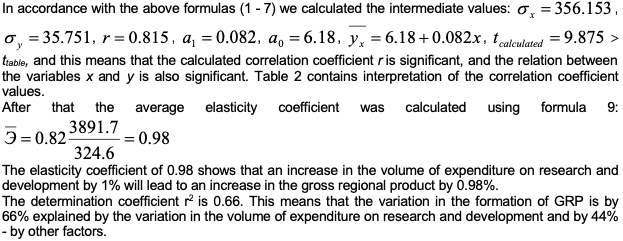
Table 2
Interpretation of the correlation
coefficient values (Gromyko, 2015)
Value of the correlation coefficient r |
Interpretation characterizing the strength of relationship |
0 < r ≤ 0.2 |
Very weak direct correlation |
0.2 < r ≤ 0.5 |
Weak direct correlation |
0.5 < r ≤ 0.7 |
Average direct correlation |
0.7 < r ≤ 0.9 |
Strong direct correlation |
-0.2 ≤ r < 0 |
Very weak inverse correlation |
-0.5 ≤ r < -0.2 |
Weak inverse correlation |
-0.7 ≤ r < -0.5 |
Average inverse correlation |
-0.9 ≤ r < -0.7 |
Strong inverse correlation |
In accordance with the data of Table 2, the determined value of the correlation coefficient r=0.94 corresponds to a strong direct correlation between the size of the GRP and the expenses for research and development in the region. The result obtained allows us to conclude that the amount of expenditure on research and development spent by organizations within the scientific and educational cluster has a direct impact on the size of the resulting gross regional product.
The study included a correlation-regression analysis of the dependence between the size of the GRP of the Penza region and the number of universities conducting research and development (Table 3).
Table 3
Correlation-regression analysis of the dependence between the size of the
GRP and the number of universities conducting research and development
Year |
Number of universities conducting R&D, pieces, х |
GRP in the Penza region, billion rubles, у |
x2 |
ху |
y2 |
yz |
2013 |
2 |
270.4 |
4.0 |
540.8 |
73116.2 |
169.8 |
2014 |
4 |
295.2 |
16.0 |
1190.8 |
88625.3 |
312.8 |
2015 |
4 |
343.3 |
16.0 |
1304.4 |
106341.2 |
312.8 |
2016 |
5 |
348.9 |
25.0 |
1812.5 |
131406.3 |
384.2 |
2017 |
6 |
365.2 |
36.0 |
2271.6 |
143338.0 |
455.7 |
Sum |
21.0 |
1635.3 |
97.0 |
7120.1 |
542826.9 |
1527.6 |
Average value |
4.2 |
327.1 |
19.4 |
1424.0 |
108565.4 |
327.1 |
Average square |
17.6 |
106968.2 |
376.4 |
2027833.0 |
11786440431.8 |
1287.5 |
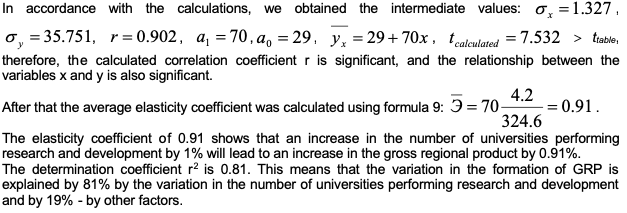
Leading Penza universities have introduced an effective innovation infrastructure, which includes technology transfer centers, innovation and analytical departments, student research and production business incubators, and management of organizational and methodological support for R&D. At the same time, technology transfer centers contribute to the integration of science and industry in the region.
Personnel potential is an important factor in the innovation activities of universities. Table 4 shows the results of the correlation-regression analysis of the dependence between the size of the GRP and the number of universities’ staff engaged in research and development.
Table 4
Correlation-regression analysis of the dependence between the size of the GRP in
the Penza region and the number of staff engaged in research and development
(Federal State Statistics Service of Russia, 2019)
Year |
Staff engaged in R&D, thousand people, х |
GRP in the Penza region, billion rubles, у |
x2 |
ху |
y2 |
yz |
2013 |
5.583 |
270.4 |
31.2 |
1509.6 |
73116.2 |
328.8 |
2014 |
5.684 |
295.2 |
32.3 |
1677.9 |
87143.0 |
216.0 |
2015 |
5.79 |
343.3 |
33.5 |
1987.7 |
117854.9 |
220.4 |
2016 |
4.69 |
348.9 |
22.0 |
1636.3 |
121731.2 |
175.0 |
2017 |
5.81 |
365.2 |
33.8 |
2121.8 |
133371.0 |
221.2 |
Sum |
27.6 |
1623.0 |
152.8 |
8933.4 |
533216.3 |
1119.0 |
Average value |
5.5 |
324.6 |
30.6 |
1786.7 |
106643.3 |
208.9 |
Average square |
30.4 |
105365.2 |
933.4 |
3192239.7 |
11372786609.7 |
1235.4 |
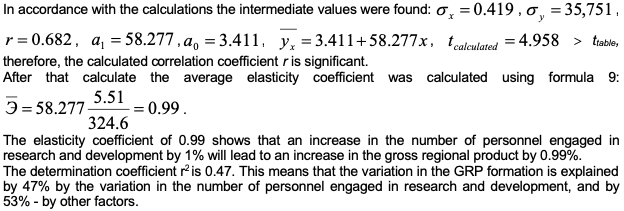
Universities and research institutes have a significant impact on the level of regional development, because they implement comprehensive fundamental and applied research and development for state and non-state customers, including projects on the basis of grants provided by domestic and foreign foundations, they also render scientific, educational and consulting services to legal entities and individuals. At the same time, the effective activity of research and educational organizations contributes to:
- Performance of research, expert, analytical and other works for state and municipal customers, executive bodies and local government, as well as private companies;
- Implementation of international scientific cooperation, participation in joint research with Russian and foreign partners, holding of all-Russian and international conferences, meetings, symposia with a view to entering the world system of science and education and presenting their own scientific products;
- Formation of an attractive investment and business climate, and a favorable reputation of the region.
According to the calculation results, it can be concluded that the socio-economic development of the region depends largely on the number and quality of work of the universities’ staff engaged in research and development. At the same time, universities are centers for broadcasting cultural heritage and research centers; they form small innovative enterprises, enjoy grant support from various scientific foundations and accumulate significant funds in research and development.
The study results allow us to conclude that higher education institutions make an integrative contribution as a driver for the economic development of the region, which can be shown as follows:
- Multiplier effect of economic development (tax deductions of universities in the regional budget, income received from foreign students and teachers);
- Universities prepare qualified workers for the labor market, whose salaries are generally higher than those who do not have university education, which directly and indirectly provides a higher tax income for the region and a higher level of consumption from a part of the population;
- Innovative development (production of new technologies and knowledge, commercialization of developments, number of licenses and patents);
- From the point of view of the state, the number of citations of publications in the databases of the Russian and international scientific indices is also important.
The results of the correlation-regression analysis of the impact of indicators of the universities’ performance assessment on the size of the GRP in the Penza region are presented in Table 5.
Table 5
Summary results of the correlation-regression analysis of the influence of
the integrative activities of universities on regional development indicators
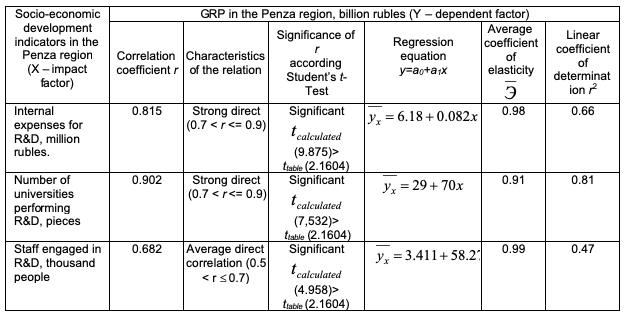
Thus, due to the revealed strong correlation between the key economic indicator of the region’s GRP and the universities’ research activities based on calculation of correlation coefficients (r), elasticity coefficients ( ), and determination coefficients (r2), it is possible to influence the economic development of the region. We illustrate this aspect with the help of the trend predicted values of factor attributes (indicators of the universities’ research activities) and calculation of the productive attribute value (GRP) based on the obtained regression equations.
Figure 1 presents a graphical interpretation of the obtained regression equations reflecting the dependence of the GRP on the results of the universities’ research activities.
Figure 1
Graphical interpretation of the obtained regression equations reflecting the
dependence of the GRP on the results of the universities’ research activities.

Thus, due to the revealed strong correlation between the key economic indicator of the region’s GRP and the universities’ research activities based on calculation of correlation coefficients (r), elasticity coefficients ( ), and determination coefficients (r2), it is possible to influence the economic development of the region. We illustrate this aspect with the help of trend predicted values of factor attributes (indicators of the universities’ research activities) and calculation of the value of the productive attribute (GRP) based on the obtained regression equations.
Figure 2 shows the trend lines and the predicted values of the indicators of the universities’ research activities.
Figure 2
Trend lines and predicted values of еру
indicators the universities’ research activities
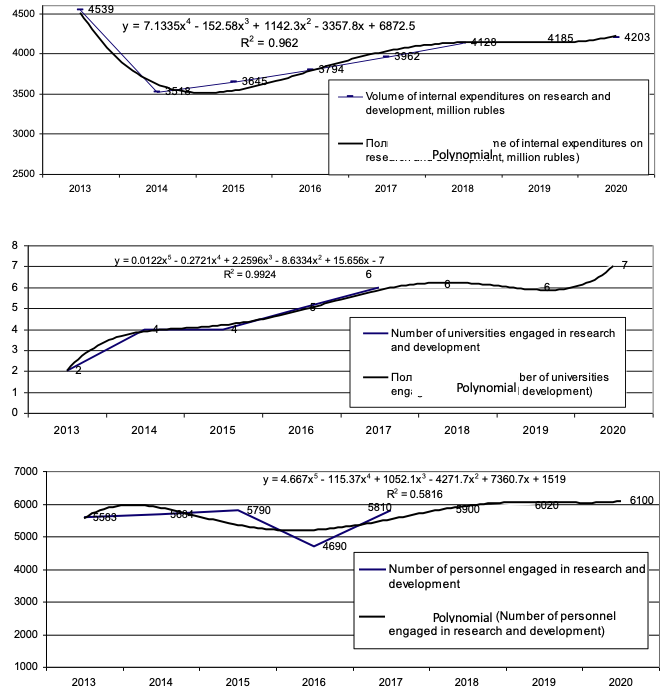
Based on the obtained predicted values, the GRP indicator for 3 years was calculated based on the obtained regression equations (Table 6).
Table 7
Calculation of predicted values of the resulting attribute (GRP) based on the obtained
predicted values of factor attributes (indicators of the universities’ research activities) and
regression equations
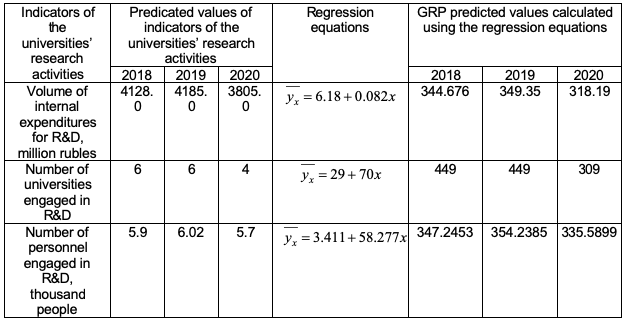

Table 8
Calculation of MAPE and Forecast Accuracy indicators for factor attributes
(indicators of the universities’ research activities) and the resulting attribute (GRP)
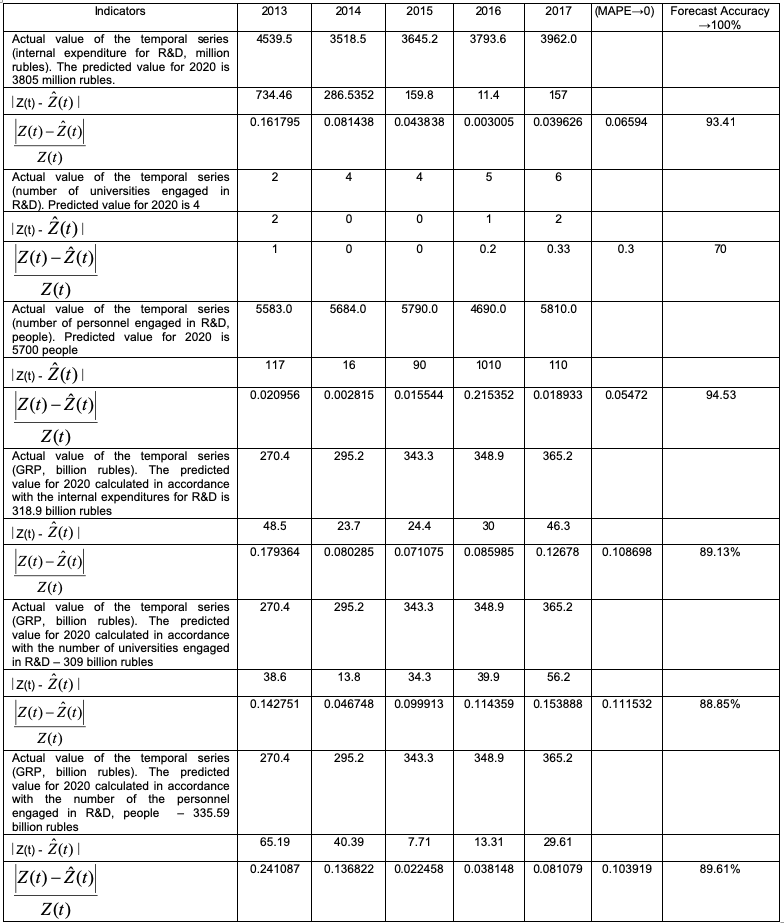
Thus, based on the calculated MAPE and Forecast Accuracy indicators for the obtained predicted values, we can conclude that the predicted level of factor attributes (indicators of the universities’ research activities) and the resulting attribute is highly accurate, for all factor attributes MAPE ≤ 0.3, and Forecast Accuracy ³ 70%, and for the resulting indicator (GRP level) MAPE ≤ 0.11, and Forecast Accuracy ³ 88%. The obtained MAPE and Forecast Accuracy values confirm the reliability of the proprietary method for assessing the impact of the universities’ research activities on the GRP level and the predicted values of such indicators.
Based on the analysis performed, it can be concluded that the indicators of assessing the impact of the universities’ integrative activities on the socio-economic component of regional development have a direct impact on the level of gross regional product. At the same time, formation of an effective system of regional universities in each constituent territory of Russia should ensure growth of socio-economic indicators of the regional development, which will contribute to the formation of a knowledge-intensive innovative economy and development of industries and complexes of great priority for the region.
Assessing the impact of universities on the socio-economic and cultural component can contribute to the typology of regional higher education systems: drivers of regional development; higher education systems with high, moderate and low levels of influence.
This ranking shows the degree of contribution of regional higher education systems to the specific socio-economic situation in the region. At the same time, regional higher education systems make different contributions to the local economy, which is determined by the influence of various factors: geographical, historical, social, etc.
Socio-economic development is influenced by the relationships between the university and the key groups of stakeholders, and only interaction with other education institutions and civil society organizations is aimed exclusively at solving their internal problems. The impact can be either direct, for example, in the case of regional authorities and the labor market, or indirect, through the development of commercial enterprises (located in the region) and the innovation component of their activities.
The existing models for assessing the region’s economic potential, such as Economic Development Report Card 2018 (2018) (DRC), EU Regional Competitiveness Index (Annoni and Dijkstra, 2013) use a significant number of factor indicators that determine the increase or decrease in the GRP value. As a rule, such models use indicators for assessing the natural resource potential, general development level of entrepreneurship and market in the territory, personnel, etc. However, despite a fairly large number of indicators, such methods for assessing the development of the regional economy based on the systematic approach do not take into account the importance of assessing the impact of R&D of educational organizations on the GRP.
The method proposed by the authors complements the Model of multifunctional and multi-level participation of the university in the regional development of P.Arbo and P. Benneworth (2007), proving that financing of the universities’ research activities contributes to the achievement of positive socio-economic results in the regional economy and enables to calculate the quantitative parameters of such impact.
Based on the study results, it was revealed that the results of the universities’ integrative activities have a direct impact on the socio-economic and cultural component of regional development. At the same time, higher education institutions are large and bona fide taxpayers; promote the growth of federal funds in the region through subsidies; act as a customer and consumer of goods and services, stimulating the economic activity of regional enterprises; are research centers; create innovative enterprises, thereby stimulating tax revenues to the regional budget and the growth of GRP; contribute to the financial development of the regional economy through stimulating consumer demand (including by attracting foreign students and teachers) and through paying high (in terms of the region) wages to the teaching staff.
Thus, formation and implementation of integrative activities by regional universities within the system of regional development institutions allows to increase the economic efficiency of the region and achieve positive socio-economic results: increase in the number of small and medium-sized businesses; growth of GRP and indices of industrial production in the region; increase in the investment attractiveness of the region; growth of the level of health care, standards of life, employment rate and incomes of the population in the region, and as a result - increase in the income level of the consolidated budgets of the constituent entities of the Russian Federation.
This study was carried out within the framework of the 2017 government assignment of the Russian Federation on the topic “Creating a Registry and a System of Performance Indicators for Regional Development Institutions” (approved by the Deputy Prime Minister of the Russian Federation on March 7, 2017 No. 1508p-P17, VTK-GZ-38-17).
Annoni P. and Dijkstra L. 2013. EU Regional Competitiveness Index RCI 2013. European Commission, Joint Research Centre, Institute for Security and Protection of the Citizens. Luxembourg: Publications Office of the European Union https://ec.europa.eu/regional_policy/sources/docgener/studies/pdf/6th_report/rci_2013_report_final.pdf
Arbo, P. and Benneworth P. (2007). Understanding the Regional Contribution of Higher Education Institutions: A Literature Review. OECD Education Working Papers, 9, OECD Publishing. DOI: 10.1787/161208155312
Caffrey, D., and Isaacs, H. (2012). Universities and Regional Development: A Critical Assessment of Tensions and Contradictions. London: Routledge.
Clark, B. (2003). The higher education system: Academic organization in cross-national perspective. Los Angeles: University of California Press.
Economic Development Report Card 2018 (DRC) URL: https://www.regionalchamber.com/docs/default-source/ed-documents/ed-report-card.pdf?sfvrsn=9158050b_10
Etzkowitz, H., and Leydesdorff, L. (2003). The triple helix – university – industry – government relations: a laboratory for knowledge-based economic development. EASST Review 14 (1): 14-19.
EU Regional Competitiveness Index RCI2013 https://ec.europa.eu/regional_policy/en/information/publications/studies/2013/eu-regional-competitiveness-index-rci-2013
Federal State Statistics Service of Russia – The official website of the Federal State Statistics Service of the Russian Federation. http://www.gks.ru/
Goddard J. B., and Chatterton Р. (2000). The response of universities to regional needs. European Journal of Education, 35(4), 475–496.
Goddard, J.B., and Chatterton, Р. (2004). The response of universities to regional needs. European Journal of Education, 35(4), 475-496.
Gromyko, G.L. (2015). Theory of statistics: a textbook. Moscow: INFRA-M.
Hamoud, A. K., and Humadi, A. M. (2019). Student’s success prediction model based on artificial neural networks (ANN) and a combination of feature selection methods. Journal of Southwest Jiaotong University, 54(3). http://jsju.org/index.php/journal/article/view/305
Hashim, A. S., Hamoud, A. K., and Awadh, W. A. (2018). Analyzing students’ answers using association rule mining based on feature selection. Journal of Southwest Jiaotong University, 53(5). http://jsju.org/index.php/journal/article/view/236
Hanushek, E.A. (2016). Will more higher education improve economic growth? Oxford Review of Economic Policy, 32(4): 538-552.
Hanushek, E.A., and Woessmann L. (2015). Do better schools lead to more growth? Cognitive skills, economic outcomes and causation. Journal of Economic Growth, 17: 267-321.
Hu, J., Liu, H., Chen, Y., Qin, J. (2018) Strategic planning and the stratification of Chinese higher education institutions. International Journal of Educational Development, 63, 36-43.
JSC Development Corporation of the Penza region – The official website of JSC Development Corporation of the Penza region. http://krpo.ru/.
Ramísio, P.J., Pinto, L.M.C., Gouveia, N., Costa, H., Arezes, D. (2019) Sustainability Strategy in Higher Education Institutions: Lessons learned from a nine-year case study. Journal of Cleaner Production, 222, 300-309.
Shields, R. (2019). The sustainability of international higher education: Student mobility and global climate change. Journal of Cleaner Production, 217, 594-602.
Tynnikov, Yu.S. (2014) Preparation of future pedagogues form innovation activity: the present state and unresolved issues. European Journal of Contemporary Education, 1(7), 63-80.
Xu, X., Li, X., Qi, G., Tang, L., Mukwereza, L. (2016). Science, Technology, and the Politics of Knowledge: The Case of China’s Agricultural Technology Demonstration Centers in Africa. World Development, 81, 82-91.
Yao, Y. (2019) Does higher education expansion enhance productivity? Journal of Macroeconomics, 59, 169-194.
1. Doctor of Economics (Ph.D.), Professor, Professor, Management, Computer Science and Humanities Science Department, the Penza branch of Financial University under the Government of the Russian Federation, Penza, Russia
2. Candidate of Economics (Ph.D.), Associate Professor, Management, Computer Science and Humanities Science Department, the Penza branch of Financial University under the Government of the Russian Federation, Penza, Russia. Contact e-mail: tanina.mara@yandex.ru
3. Candidate of Economics (Ph.D.), Associate Professor, Management, Computer Science and Humanities Science Department, the Penza branch of Financial University under the Government of the Russian Federation, Penza, Russia.
4. Candidate of Economics (Ph.D.), Head of the Department of Management, Computer Science and Humanities Science, the Penza branch of Financial University under the Government of the Russian Federation, Penza, Russia.